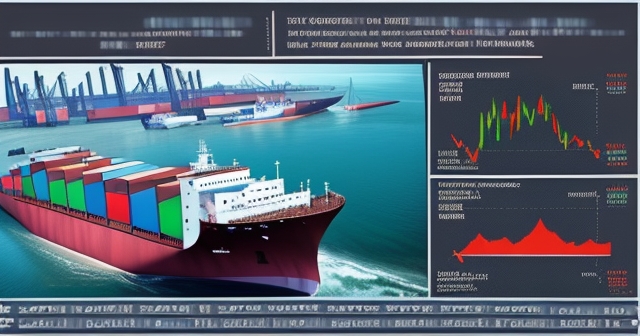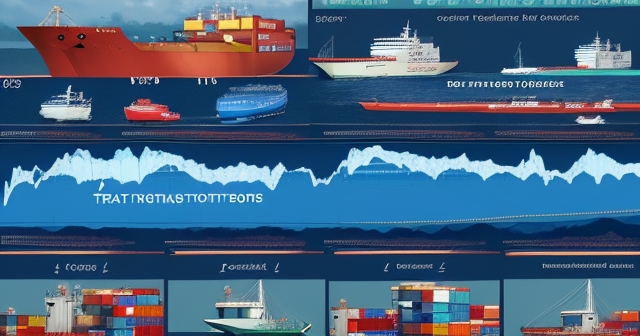Understanding the Pulse of Global Commerce: A Deep Dive into the US Balance of Trade
Welcome, aspiring investors and traders! We’re about to embark on a journey into one of the most critical economic indicators shaping the global financial landscape: the United States Balance of Trade. If you’ve ever wondered how the flow of goods and services between nations impacts everything from currency values to stock markets, you’re in the right place. Think of the Balance of Trade as a nation’s economic scorecard with the rest of the world. It’s a simple concept at its core – the difference between what a country sells (exports) and what it buys (imports). But as you’ll soon discover, the implications are far-reaching and complex, offering invaluable insights for those seeking to navigate the financial markets effectively.
For both new investors building a foundational understanding and seasoned traders refining their technical analysis, grasping the nuances of trade data is essential. It’s not just a statistic; it’s a reflection of economic health, consumer demand, global competitiveness, and the intricate web of international relationships. Throughout this discussion, we’ll break down the latest figures, explore the driving forces behind them, examine historical trends, and most importantly, connect the dots between this seemingly dry data and its tangible effects on your potential trading decisions and investment strategies.
By the end of our exploration, you’ll not only understand *what* the US Balance of Trade is but also *why* it matters so profoundly in the world of finance. Ready to decode this vital economic signal together?

The Latest Snapshot: Unpacking the Recent US Trade Deficit Figures
Let’s start with the most current information available, as this often provides the immediate context for market reactions. Recently, the United States reported a significant widening of its trade deficit. For April 2024, the deficit reached $74.6 billion USD. To put this into perspective, this was larger than the March 2024 deficit, which was initially reported around $68.6 billion (later revised slightly), and represents the largest trade gap recorded since October 2022.
What does a widening trade deficit signal? Primarily, it means that in that specific period, the US imported significantly more goods and services than it exported. While the April figure was slightly below some analyst forecasts (which anticipated around $76.1 billion), the fact that it expanded notably from the previous month is a key takeaway. This movement indicates shifts in the underlying dynamics of US international trade – either exports are slowing down, or imports are accelerating, or a combination of both.
Looking slightly ahead, the May 2024 data continued to show a large deficit, coming in at $75.10 billion USD, close to the April level and slightly below the May forecast of $76.30 billion. This suggests the trend of a substantial trade gap persisted into the following month. These figures are not just numbers on a page; they are indicators that economists, policymakers, and traders pore over, seeking clues about the health and direction of the US economy and its global standing.
Understanding the latest numbers is the first step. But to truly grasp their meaning, we must dig deeper into the components that constitute this balance. What exactly is the US buying more of, and what is it selling less of (or not selling more of)?
Deconstructing the Balance: A Closer Look at Imports and Exports
The trade balance is fundamentally a calculation: Total Exports minus Total Imports. Therefore, any change in the balance must be driven by movements in either exports or imports, or both. The recent widening of the US trade deficit in April 2024 provides a clear illustration of this dynamic.
In April 2024, we saw a substantial increase in imports. Total imports rose by a significant 8.7%, reaching a value of $338.2 billion USD. This is a considerable jump and was the primary driver behind the larger deficit. What were Americans and US businesses buying more of?
Key categories that saw notable increases included:
- Passenger cars: Reflecting strong consumer demand or perhaps businesses upgrading fleets.
- Computer accessories and telecommunications equipment: Indicating continued investment in technology and consumer electronics purchases.
- Crude oil: A significant import category, sensitive to global energy markets and domestic energy needs.

The surge in imports suggests robust domestic demand – consumers and businesses are willing and able to purchase goods from abroad. However, from a trade balance perspective, higher imports without a commensurate rise in exports lead to a larger deficit. In April 2024, while imports surged, exports also increased, but at a much more modest rate of 0.8%, totaling $263.7 billion USD.
Which export categories contributed positively?
- Pharmaceutical preparations: Highlighting the strength of the US pharmaceutical industry in global markets.
- Electric apparatus and semiconductors: Indicating demand for US technology and manufactured goods.

Comparing the growth rates (8.7% for imports vs. 0.8% for exports) makes it clear why the deficit widened. The inflow of goods and services into the US significantly outpaced the outflow. This tells us something important about the relative strength of US domestic demand compared to global demand for US products, or perhaps factors affecting the cost or availability of US exports.
It’s also crucial to remember that the trade balance includes both goods and services. While the goods balance often dominates the headline number due to its sheer volume, the services sector plays a vital role. The US typically runs a surplus in services trade (selling more services like finance, education, tourism, and intellectual property abroad than it buys). Changes in the services surplus can partially offset movements in the goods deficit. For example, in March 2024, the services surplus increased, even as the goods deficit widened, partially mitigating the overall deficit increase.
Analyzing these components helps us move beyond the single deficit number to understand the underlying economic activity. Is the increase in imports a sign of a healthy, demanding economy? Is the slower growth in exports a concern about global slowdowns or competitiveness? These are the kinds of questions analysts ask when looking at this data.
Navigating the Global Network: Trade Balances with Key Partners
The overall US trade balance is an aggregate figure. To gain a deeper understanding, we need to look at the balance of trade with specific countries and economic blocs. These bilateral balances reveal the dynamics of the US’s most important trading relationships and can highlight specific areas of tension or cooperation.
The data for April 2024 showed some notable shifts in bilateral trade balances:
- European Union (EU): The trade deficit with the EU widened significantly, increasing by 11% to reach $-22.5 billion USD. This indicates the US imported considerably more from the EU relative to its exports in April. This could be influenced by factors like currency exchange rates between the USD and the Euro, specific demand for European goods (like luxury items, automobiles, or machinery), or differences in economic growth rates.
- China: The trade deficit with China, often the largest bilateral trade gap for the US, actually narrowed in April 2024, falling by 11% to $22 billion USD. While still a substantial deficit, this narrowing is noteworthy. It could be attributed to a variety of factors, including evolving supply chain strategies by US companies, changes in Chinese domestic demand, or the ongoing impact of trade policies and tariffs between the two nations.
- Mexico: The deficit with Mexico also decreased, falling by 5% to $12.8 billion USD in April 2024. Mexico is a critical trading partner under the USMCA agreement (formerly NAFTA), and changes in this balance are often linked to integrated manufacturing supply chains, particularly in the automotive sector. The narrowing deficit suggests a relative shift in the flow of goods between the two countries during the month.

Looking back slightly, the February 2024 data highlighted different dynamics. The goods deficit with China had narrowed to $21.9 billion then, while the goods shortfall with Mexico had widened to a record $15.3 billion. These month-to-month fluctuations demonstrate the dynamic nature of international trade, influenced by seasonal factors, specific industry trends, and global economic events.
Historically, the US has run its biggest trade deficits with countries known for their manufacturing prowess and large export-oriented economies, such as China, Mexico, Vietnam, Germany, and Japan. Conversely, it often runs surpluses with countries that are major buyers of US services or specific high-value goods, like the Netherlands, Hong Kong (often a re-export hub), Australia, and the United Kingdom.
Tracking these partner-specific balances is crucial because they inform diplomatic relations, trade policy negotiations, and can influence investment decisions related to specific geographic markets.
A Look Back: The Historical Context of the US Trade Balance
Understanding the current trade figures requires placing them within their historical context. The US trade balance has not always been in deficit. In fact, for much of its early history and through the period following World War II, the US often ran trade surpluses, exporting more than it imported.
However, a significant shift occurred in the mid-1970s. The United States has consistently run trade deficits every year since 1976. This persistent deficit is a defining feature of the modern US economy’s relationship with the rest of the world.
Why this shift? Several factors contributed to the move from surplus to persistent deficit:
- Globalization: Increased ease of international trade and lower shipping costs made it easier for US companies and consumers to access goods from abroad.
- Rise of Manufacturing Hubs: The emergence of countries like Japan, and later China and other Asian nations, as major manufacturing powerhouses capable of producing goods competitively for the global market.
- Strong Domestic Demand: The US economy has often experienced robust consumer demand, fueled by population growth, rising incomes, and access to credit, leading to a high propensity to import goods.
- The US Dollar’s Role: The USD’s status as the world’s primary reserve currency means there is constant global demand for dollars (for international transactions, investments, central bank reserves). This demand can keep the dollar’s value relatively high, making US exports more expensive for foreign buyers and imports cheaper for US buyers, contributing to a deficit.
- Offshoring: US companies moving manufacturing operations abroad to reduce costs led to importing goods that were previously produced domestically.

Looking at the historical range, the average US trade balance from 1950 to 2024 is around $-18.00 billion USD, reflecting the long period of deficits. The record high surplus was $1.95 billion way back in June 1975, just before the shift occurred. Conversely, the record low (largest deficit) was a staggering $-101.91 billion USD in March 2022, driven by a confluence of factors including pandemic-related supply chain disruptions and surging demand.
The recent deficit figures, while large ($74.6 billion in April 2024), are significant because they represent the largest gap since late 2022, potentially signaling renewed pressure or specific policy impacts rather than just a continuation of the long-term trend.
Considering the future, some projections based on potential policy changes, such as anticipated tariff increases, suggest large deficits could persist or even grow. Reports citing figures around $98.4 billion for December 2024 and potentially $140.5 billion for March 2025 indicate that forecasters are factoring in policy effects that could significantly impact import costs and volumes.
Macroeconomic Ripples: How Trade Data Impacts Currency and Markets
Why do economists, central bankers, and financial market participants pay so much attention to the monthly trade balance release? Because its implications extend far beyond just the difference between imports and exports. This data point has tangible effects on currency values, inflationary pressures, domestic production, and overall market sentiment.
One of the most direct links is to the US Dollar (USD). In simplified terms, when the US imports goods and services, dollars flow out of the country to pay for them. When the US exports, dollars flow in. A trade deficit means there is a net outflow of dollars related to trade activities. Conversely, a trade surplus implies a net inflow.
In the foreign exchange (forex) market, currency values are determined by supply and demand. A large trade deficit can, in theory, increase the supply of USD on the global market relative to demand (as dollars are sold to buy foreign currency for imports), potentially putting downward pressure on the dollar’s value. Conversely, a narrowing deficit or a surplus can decrease the supply of USD or increase demand (as foreign buyers need USD to buy US exports), potentially strengthening the dollar.
Therefore, a trade balance report that shows a smaller deficit than expected or a larger surplus than expected is generally considered positive or bullish for the USD. Conversely, a report showing a larger deficit than expected is often interpreted as negative or bearish for the USD.
Beyond currency, the trade balance impacts the domestic economy:
- Gross Domestic Product (GDP): Net exports (Exports minus Imports) are a component of GDP. A widening trade deficit subtracts from GDP growth, while a narrowing deficit or surplus adds to it.
- Domestic Production and Employment: Strong export demand supports domestic industries and creates jobs. High import levels can indicate strong domestic demand but can also compete with domestic producers, potentially impacting local employment in import-competing sectors.
- Inflation: Import prices can influence domestic inflation. If imports become more expensive (due to a weaker dollar or tariffs), it can contribute to rising consumer prices.
The Influence of Trade Policy, Especially Tariffs
The recent trade data has been explicitly linked to trade policy, particularly the use of tariffs. Tariffs are taxes imposed on imported goods. The data mentions that large deficits, including forecasts for late 2024 and 2025, are linked to expected tariff increases. How does this work?
When tariffs are announced or anticipated, businesses that rely on those imports often have an incentive to increase their imports *before* the tariffs go into effect. This rush to “beat the tariff deadline” can cause a temporary surge in imports, widening the trade deficit in the short term, even if the long-term goal of the policy is to reduce imports or encourage domestic production.
The data specifically references policies under President Donald Trump. While the mention of future tariffs doesn’t explicitly name a president, it highlights the ongoing impact and anticipation of such trade measures. Trade policies like tariffs create uncertainty and can lead to:
- Increased costs for businesses and consumers.
- Retaliation from other countries, leading to tariffs on US exports.
- Disruption of global supply chains.
- Increased volatility in financial markets.
Indeed, the data explicitly links trade issues and potential “tariff fallout” to broader market concerns, such as stock market volatility and even recession fears. It notes how trade tensions can lead to price target reductions for major companies (mentioning examples like Tesla and Apple, likely due to their significant international sales and supply chains). This demonstrates how macro-level trade data and policy can directly affect the performance of individual companies and the broader equity markets.
Understanding these connections is vital for traders and investors. A surprise in the trade balance report can cause immediate reactions in the forex market and ripple effects in equity and bond markets. Moreover, tracking trade policy developments provides crucial context for interpreting the data and anticipating future economic trends.
Applying Trade Data in Your Analysis: More Than Just a Number
For those of you focused on technical analysis, incorporating macroeconomic data like the Trade Balance might seem outside your usual charting toolkit. However, fundamental data provides the crucial economic backdrop against which price action unfolds. While you might not draw trendlines on a trade deficit chart, understanding its implications can give you an edge in interpreting market movements, especially around the data release time.
Consider this: a technical indicator might signal potential USD strength, but if a significantly larger-than-expected trade deficit is announced, that fundamental news could quickly override technical signals, leading to immediate USD weakness. Conversely, a surprisingly narrow deficit could fuel a strong technical breakout in USD pairs.
For traders operating in the forex market, the trade balance is a high-impact news event. The Bureau of Economic Analysis (BEA) and the U.S. Census Bureau release this data monthly, typically around 8:30 AM Eastern Time. Traders watch closely for deviations from forecasts, as these surprises are what usually trigger sharp price movements.
If you’re involved in stock trading, consider which sectors or companies are heavily reliant on exports (e.g., aerospace, agriculture, heavy machinery) or imports (e.g., retailers, electronics manufacturers). A widening trade deficit driven by surging imports might signal robust consumer demand benefiting retailers, while an export slowdown could hurt multinational corporations with significant overseas sales.
Furthermore, trade data can influence interest rate expectations. Persistent large deficits that require foreign financing could theoretically put upward pressure on interest rates. While this is a longer-term effect and not the primary driver of monetary policy, it’s part of the complex economic equation.
Integrating fundamental knowledge, like the meaning and implications of the Trade Balance, with your technical analysis helps build a more robust trading strategy. It moves you from simply reacting to price charts to understanding the underlying forces driving those prices.
If you’re looking to trade based on these economic indicators, access to timely data and a reliable trading platform are key. Understanding how different economic releases impact various financial instruments, particularly currency pairs, is a crucial skill for any trader.
If you’re considering starting forex trading or exploring more CFD products, then Moneta Markets is a platform worth considering. Based in Australia, it offers over 1000 financial instruments, suitable for both novice and professional traders.
Challenges and Criticisms: Acknowledging the Nuances of Trade Data
While the Trade Balance is a vital indicator, it’s not without its complexities and criticisms. It’s important to view this data with a critical eye and understand its limitations.
- The Services Component: While included, the services balance often receives less attention than the goods balance in headline reports, even though the US typically runs a significant services surplus. This can sometimes distort the overall picture if one only focuses on goods.
- Capital Flows: The Trade Balance (part of the Current Account) is intrinsically linked to the Capital Account (also known as the Financial Account). A country running a current account deficit must, by definition, run a capital account surplus of equal magnitude. This means the US deficit is financed by foreign investment flowing into the US (buying US assets, stocks, bonds, real estate, etc.). Some economists argue that focusing solely on the trade deficit misses the positive signal of the US being an attractive destination for global capital.
- Currency Fluctuations: Exchange rates significantly impact the cost of imports and the competitiveness of exports. Month-to-month changes in currency values can influence the trade balance, sometimes more than underlying changes in demand or production.
- Data Revisions: Trade data is often subject to revisions in subsequent months as more complete information becomes available. Traders need to be aware that initial reports may not be the final word.
- Supply Chain Complexity: In a globalized world, goods often cross borders multiple times during production. Tracking the true origin and value added can be complex, potentially affecting the accuracy of bilateral trade figures.

Despite these challenges, the Trade Balance remains a powerful indicator of international economic flows and their immediate impact on the domestic economy and currency markets. Its value lies not just in the headline number, but in the detailed breakdown of where the deficits and surpluses lie, and which categories of goods and services are driving the changes.
For the sophisticated trader or investor, this data serves as a piece of a larger puzzle, offering insights into the global demand environment, the impact of trade policies, and potential shifts in currency valuations – all factors that can influence the success of technical trading strategies.
Conclusion: Synthesizing Insights for Informed Trading and Investment
We’ve journeyed through the intricacies of the US Balance of Trade, from the latest deficit figures to the historical context, the components of imports and exports, the dynamics with key trading partners, and its profound macroeconomic implications for currency and markets. What are the key takeaways for you as an investor or trader?
- The US Trade Balance is not merely an obscure economic statistic.
- Understanding the breakdown – which goods and services are driving the changes, and with which partners – provides a richer picture than the headline number alone.
- The Trade Balance is a significant driver of currency movements, particularly for the USD.
Finally, the data underscores the interconnectedness of trade policy and financial markets. Tariffs and trade tensions are not just political headlines; they have tangible effects on import volumes, export competitiveness, corporate earnings, and overall market sentiment, contributing to volatility.
As you continue to refine your technical analysis skills, remember to complement them with a solid understanding of fundamental economic drivers like the Trade Balance. This holistic approach will empower you to make more informed decisions, better anticipate market reactions to economic news, and navigate the complexities of the financial world with greater confidence.
Monitoring key economic releases, like the Trade Balance, is an essential part of a well-rounded trading approach. Choosing a platform that provides timely access to data and robust charting tools can significantly enhance your ability to react to these market-moving events.
When you are evaluating different brokers, Moneta Markets‘ flexibility and technological edge are worth mentioning. It supports mainstream platforms like MT4, MT5, Pro Trader, combined with high-speed execution and low spread settings, providing a good trading experience.
By integrating insights from economic indicators with your technical analysis, you are building a foundation for more strategic and potentially more profitable trading outcomes. The journey to becoming a consistently successful trader involves continuous learning, and understanding data like the US Balance of Trade is a vital step on that path.
| Month | Deficit (USD) | Export Growth (%) | Import Growth (%) |
|---|---|---|---|
| March 2024 | 68.6 Billion | 0.8 | 8.7 |
| April 2024 | 74.6 Billion | 0.8 | 8.7 |
| May 2024 | 75.1 Billion | N/A | N/A |
| Trade Partner | Deficit (USD) | Change (%) |
|---|---|---|
| European Union | -22.5 Billion | 11 |
| China | 22 Billion | -11 |
| Mexico | 12.8 Billion | -5 |
| Year | Average Trade Balance (USD) | Largest Deficit (USD) | Largest Surplus (USD) |
|---|---|---|---|
| 1950-2024 | -18.00 Billion | -101.91 Billion | 1.95 Billion |
balance tradingFAQ
Q:What is the US Balance of Trade?
A:The US Balance of Trade is the difference between the value of goods and services exported and imported by the country.
Q:Why is the Balance of Trade important?
A:The Balance of Trade is a key indicator of economic health, influencing currency values and making it crucial for investors and policymakers.
Q:How does a trade deficit affect the economy?
A:A trade deficit can indicate strong domestic demand but can also lead to currency depreciation and affect GDP growth.
